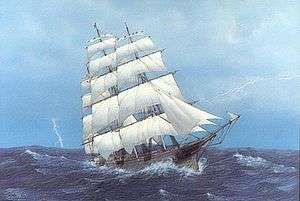Lightning (clipper)
 "Clipper Ship Lightning" | |
| History | |
|---|---|
| Owner: | James Baines & Co. |
| Ordered: | 1853 |
| Builder: | Donald McKay |
| Cost: | ₤32,000 |
| Laid down: |
|
| Launched: | 3 January 1854 |
| Christened: | 3 January 1854 |
| Acquired: | British Merchant Navy |
| Commissioned: | 18 February 1854 |
| Maiden voyage: | 18 February – 3 March 1854 to Liverpool |
| In service: | 18 February 1854 |
| Out of service: | 31 October 1869 |
| Homeport: | Liverpool |
| Fate: | scuttled 31 October 1869 at Geelong, Australia |
| General characteristics | |
| Class and type: |
|
| Tonnage: | 2,084 GRT |
| Tons burthen: | 3.500 tons |
| Length: |
|
| Beam: | 44 ft (13 m) |
| Height: | 164 ft (50 m) main mast (deck to truck) |
| Draught: | 23 ft (7.0 m) loaded |
| Propulsion: | Sails |
| Speed: | 19 kn (35 km/h); best 24-hour run: 436 nautical miles (807 km) in 1854 |
| Boats & landing craft carried: | 6 lifeboats |
| Capacity: | 1,450 tons cargo |
| Complement: | 100 crew |
Lightning was a clipper ship, one of the last really large clippers to be built in the USA. She was built by Donald McKay for James Baines of the Black Ball Line, Liverpool, for the Australia trade.[1][2]
It has been said that the Lightning was the most extreme example of a type of ship classified as an extreme clipper.
Her builder was the famous Donald McKay of Boston, a follower of John Willis Griffiths and his principles of ship design. Lightning is a prime example of a change in thinking that turned builders away from shaping ships' hulls like cod's heads and mackerel tails. She had 16 feet (4.9 m) of concavity in her bows and a beautiful fine run, yet she also had a moderate deadrise and a good full midsection with tumblehome, allowing her to be fast yet stable, with good sail-carrying ability.
History
When Lightning was built in 1854 in Boston, America's clipper boom was on the wane. The Australian gold rush was on, however, and McKay was building ships for James Baines of the "Black Ball Line" (house flag featured a black disk ("ball") on a red background) in Liverpool. Baines needed to transport passengers and cargo to Australia and had been impressed by the huge American ships. Lightning was powerfully and heavily constructed to handle the heavy seas and storms of the Australian run. Only the finest materials went into her construction. She cost ₤30,000 to build, and Baines put in another ₤2,000 in interior decoration, adding fine woods, marble, gilding and stained glass. It is said that her rooms rivaled those of the later Queen Mary. An on-ship newspaper called the Lightning Gazette was published for the passengers and crew.
After arriving in England, Lightning's hollow bow was ignorantly filled in by her captain Anthony Enright. McKay called the people who did it "the wood butchers of Liverpool". When the famous James "Bully" Forbes became her captain, he drove her mercilessly, often running with the lee rail underwater, and the fillings soon washed out. Lightning began to set records. For example, she crossed from New York to Liverpool in 13 days, 19½ hours, and she sailed 436 miles (702 km) in 24 hours, doing 18 to 18½ knots. In 1854–55, she made the passage from Melbourne to Liverpool in 65 days, completing a circumnavigation of the world in 5 months, 9 days, which included 20 days spent in port.[3]
Lightning did a brief stint as a troop ship, taking British soldiers to India to fight the 1857 Indian Mutiny.
At around 01:00 on 30 October 1869, Lightning caught fire at Geelong in Australia, when she was fully loaded and ready to sail with 4,300 bales of wool, 200 tons of copper, 35 casks of wine, and some tallow. Attempts to control the fire were unsuccessful, so at around noon the decision was taken to sink her. She was towed out to the shoals in Corio Bay where initial attempts to hole her below the waterline with cannon fire from the shore were unsuccessful. At about four in the afternoon some of the crew scuttled her by cutting holes on the waterline, and she sank in 27 feet (8.2 m) of water. The shoals became known as "Lightning Shoals".
Affiliations
- TS Lightning, Australian Navy Cadets - (Former Unit)
References
- ↑ Some famous sailing ships and their builder, Donald McKay, by Richard C. McKay. G. P. Putnam's Sons, 1928; Easton Press, 1988.
- ↑ "Lightning Victorian Heritage Register (VHR) Number S415". Victorian Heritage Database. Heritage Victoria.
- ↑ Chichester, Francis (1966). Along the Clipper Way. London: Hodder & Stoughton. p. 69. ISBN 0-340-00191-7. OCLC 3548425.
External links
- Sailing Ships: Lightning
- Voyage of the Clipper Ship Lightning from England to Australia and Back
- Lightning data
- Winchester, Clarence, ed. (1937), "The record-breaker Lightning", Shipping Wonders of the World, pp. 300–302 illustrated account of the clipper Lightning
Coordinates: 38°8′24″S 144°22′7″E / 38.14000°S 144.36861°E